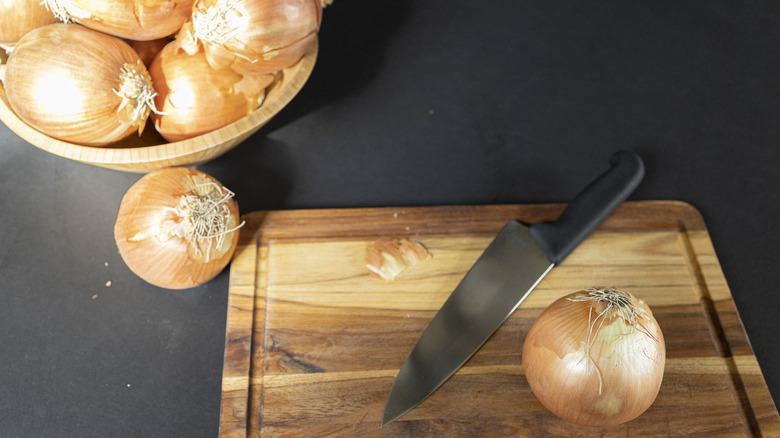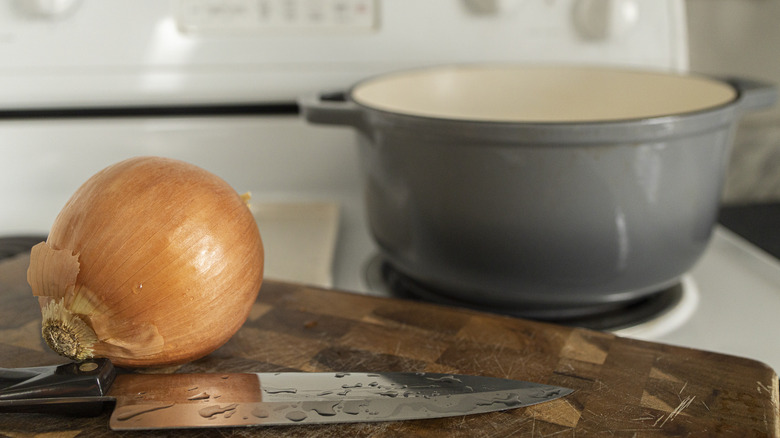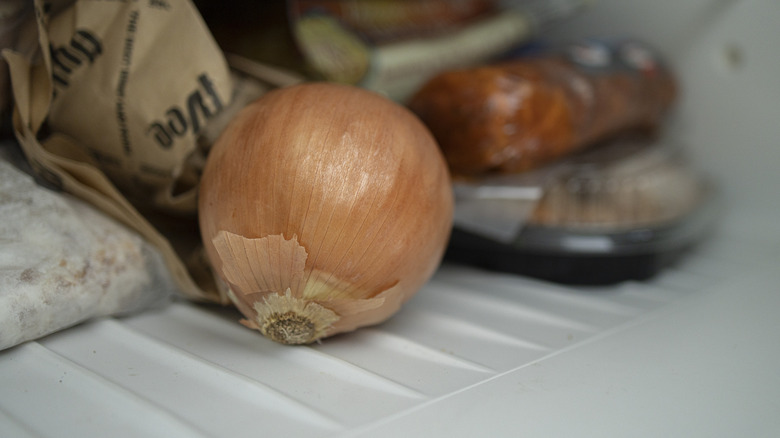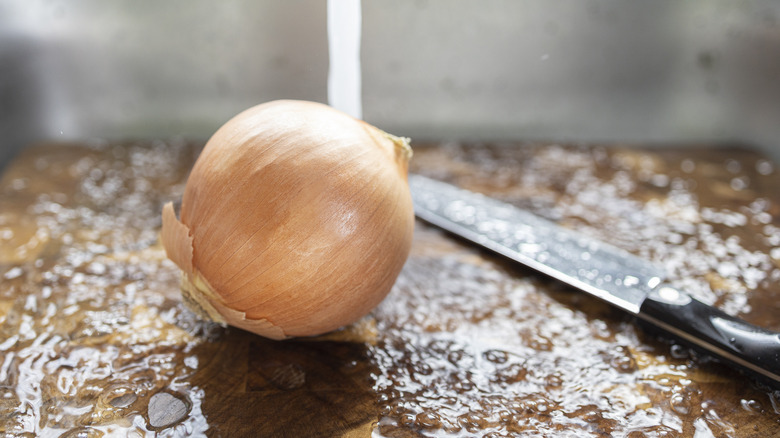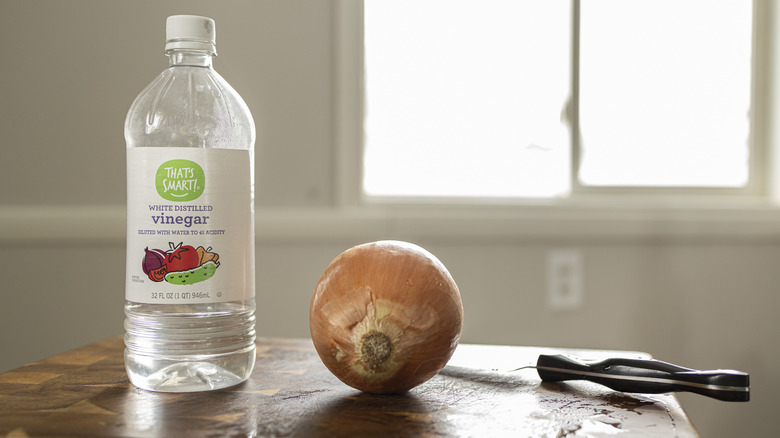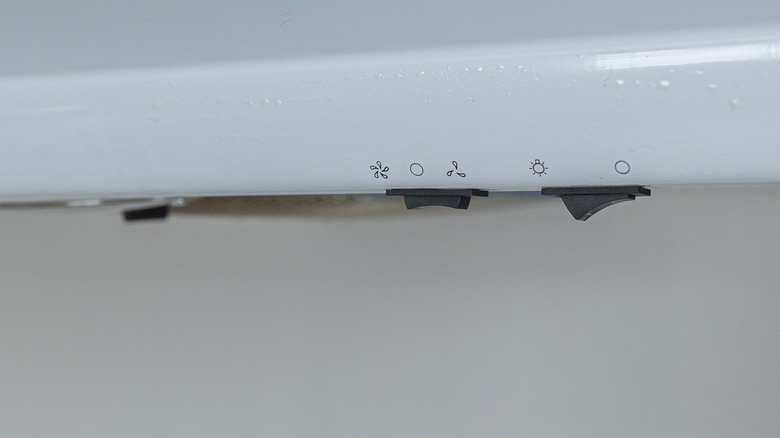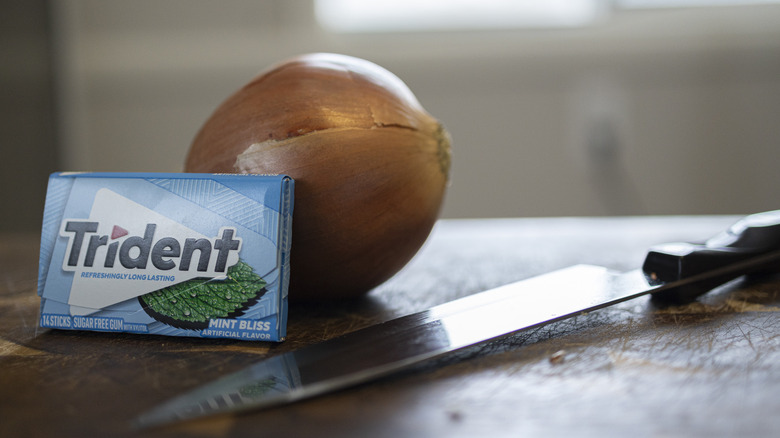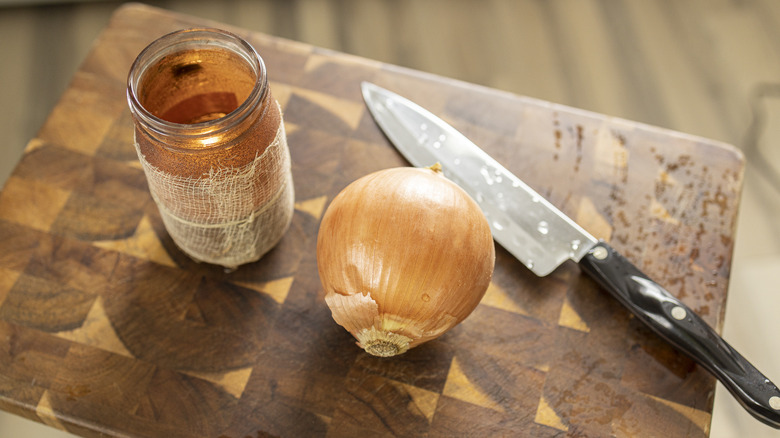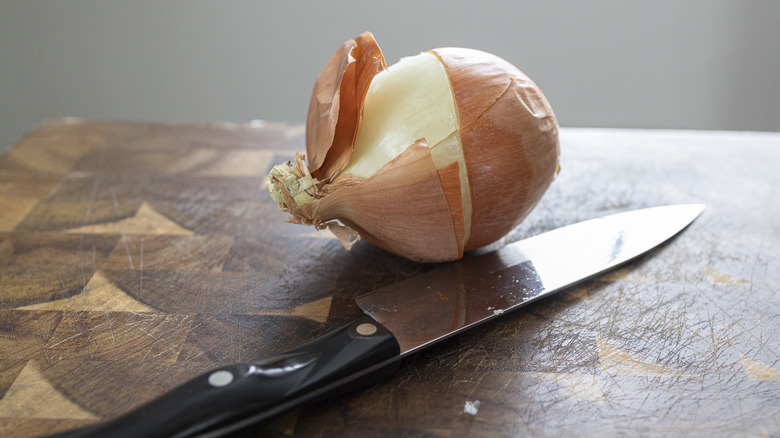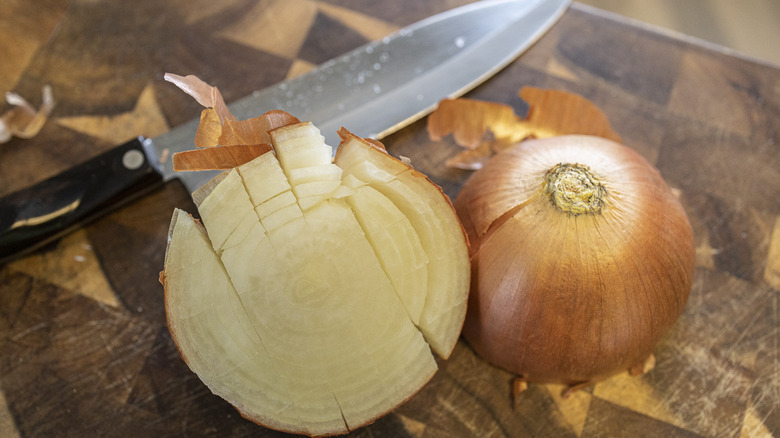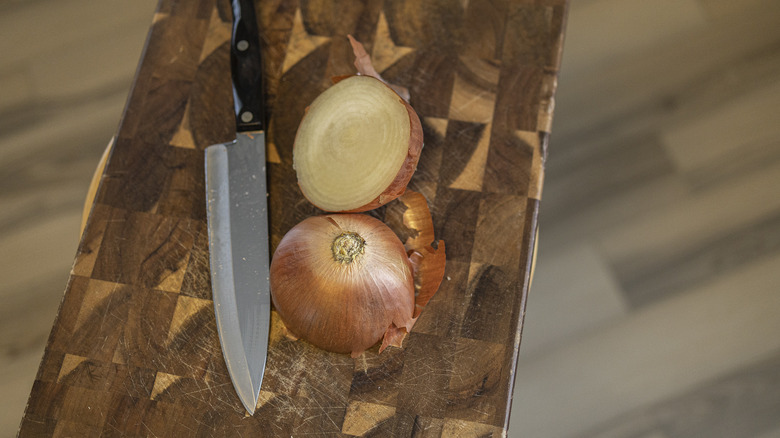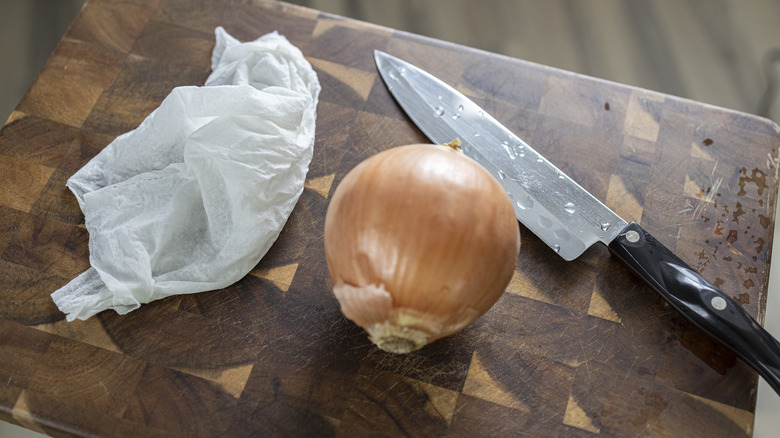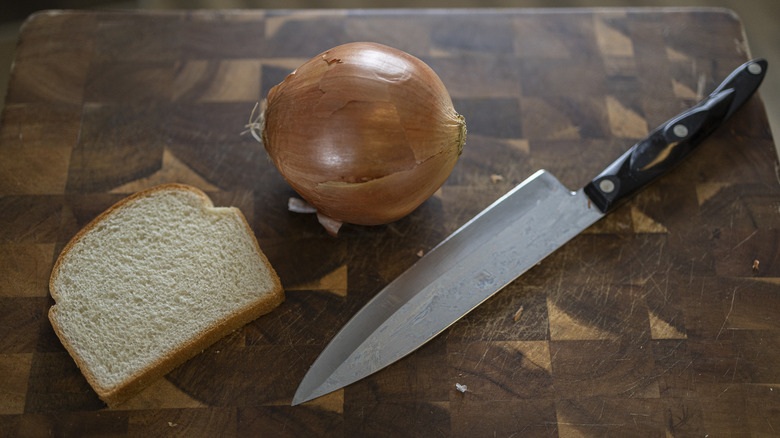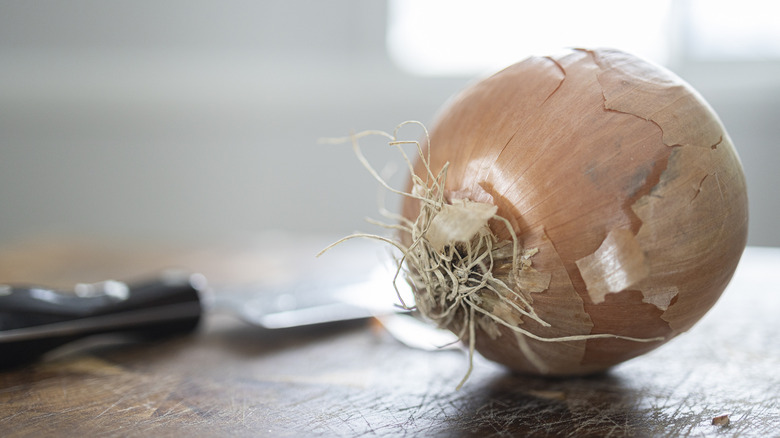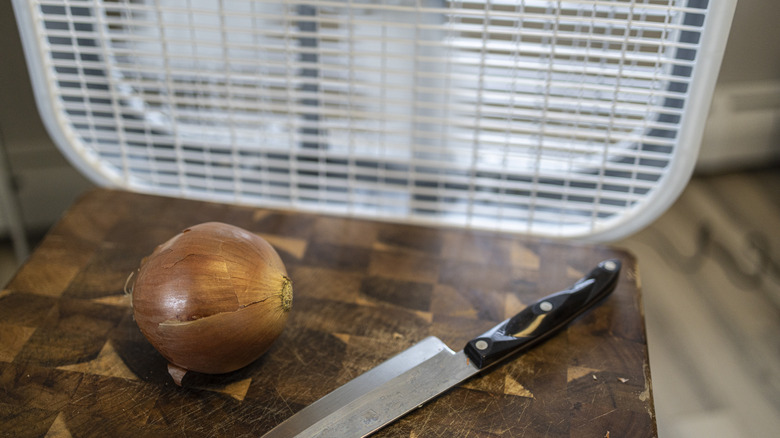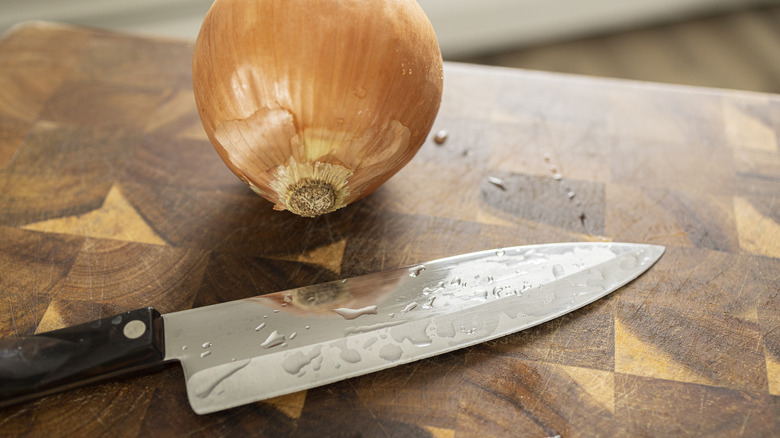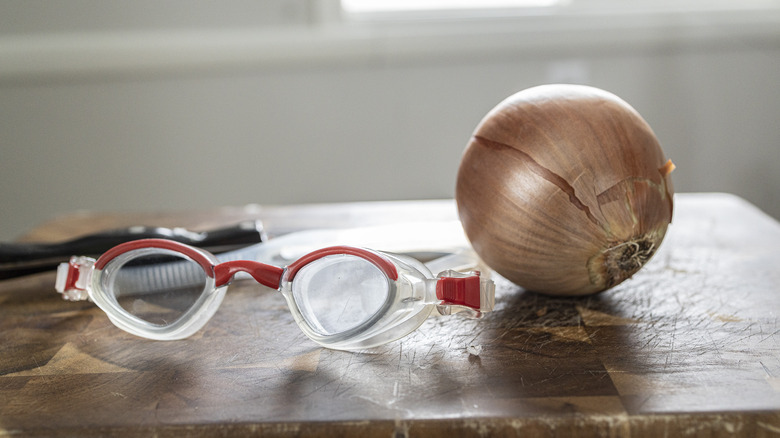We Tested 16 Hacks For Tear-Free Onion Cutting & Here's What Works
Throughout the years, the internet has blessed us with plenty of cooking hacks. But some tips are more successful than others. Every chef, either at home or in a professional kitchen, has recommendations for making the day-to-day headaches of a kitchen go away — like chopping onions without crying or creative hacks to add green onions to dishes.
Why does cutting into an onion make our eyes water? When a knife's blade damages the cells of an onion, the vegetable releases enzymes into the air that irritate nerves around our eyes. These enzymes are forms of sulfuric acid, which causes us to cry. If you're like us, you've gotten sick of cutting onions through tears! You may be familiar with some "hacks" that claim to prevent the waterworks. These tricks range from the sensible to the strange, so we set out to test a few of the most popular suggestions for tear-free onion cutting. We used room-temperature (except where noted otherwise) yellow onions and the same knife and kitchen for the most consistent results. Here are our findings on which tearless onion-cutting hacks work.
Chop next to a pot of hot water
This hack, found through WikiHow, suggests chopping an onion near a pot of hot, steamy water. The theory behind this trick is that the steam from the water will "draw out the vapors from the onion, dissipating them." We were skeptical about this train of thought: Wouldn't drawing onion vapors out bring them closer to our eyes? How is steam going to dissipate the onion's enzymes? Still, we decided to give it a fair try.
We brought a roughly halfway-full pot of water to a boil and started chopping the onion less than a foot away from the steaming pot. Unfortunately, this hack didn't help our tear ducts. The steam didn't seem capable of dissipating anything. We were full-on crybabies by the time we'd chopped one full onion. By then, the pot had also stopped steaming — meaning this hack would be impractical if you needed to cut more than one onion.
Freeze onion beforehand
The recommendation to pop an onion in the freezer for a few minutes before chopping is a popular one. We suggest chilling the onion for up to 30 minutes, as the cold will inhibit the acidic enzyme from being released into the air.
We put our onion in the freezer for 15 minutes to be on the safe side. When we took the onion out, we immediately started chopping the onion. To our surprise, this method was flawlessly effective. We cut an entire onion and there wasn't even the hint of a sting in our eyes. However, there are a few downsides and notes to keep in mind when using this hack. You want to work quickly before the onion warms back up. Since it's cold, you may be inclined to chop more quickly, but that can increase the risk of injury. You also don't want to stick four onions in the freezer and pull them out one at a time: If the vegetables were to actually freeze, they may be more difficult to chop and may have an altered flavor.
Chop under cold running water
According to Yummly, preventing tears when chopping an onion is as simple as turning on the kitchen sink. The outlet suggests that cold water will lower the temperature of the onion, slowing down the release of those eye-signing enzymes. Also, it will prevent some of the onion's chemicals from being dispersed into the air altogether.
Other sources, like WikiHow, say that this method is best applied by chopping an onion while it's fully submerged in a bowl of cold water. However, that seemed like a sliced finger waiting to happen! Instead, we opted for the running water in the kitchen sink approach. This method worked about as well as the chilled onion did, but it was more awkward, and there was still a tiny bit of sting from the chopped onion bits after they were set aside in a bowl. The freezer method is more effective since it keeps the onion colder even after it's cut.
Put vinegar on the cutting board
Another recommendation from WikiHow states that brushing your chopping board with vinegar will thwart onion-related tears. Apparently, the acidic vinegar will denature the onion's enzyme. However, WikiHow didn't elaborate on what type of vinegar to use for this method. We opted for distilled white vinegar and brushed two tablespoons across the board before chopping an onion.
While it seemed like the vinegar reduced the intensity of the onion tears, it wasn't a bulletproof method. We think the vinegar has to come into direct contact with all of the "bleeding" onion surfaces to be effective. But that doesn't happen when you're chopping an onion. There doesn't seem to be a way to apply this hack that isn't wasting time — rotating the onion so that every exposed surface touches the vinegar on the cutting board — or vinegar — soaking the onions in enough vinegar, so every part is submerged.
Chop under fume hood
This hack is for home chefs lucky enough to have a kitchen vent on their stoves. According to Ricardo Cuisine, you can prevent onion enzymes from wreaking havoc on your tear ducts by doing your chopping prep under the vent hood. The source recommends bumping the hood fan up to high so that those pesky enzymes can be vacuumed right out of the air.
We did exactly as Ricardo Cuisine told us to, and there wasn't a single tear shed — most of the time. Towards the very end of dicing the onion, it seems that enough sulphuric chemicals had escaped the hood's suction power to sting our eyes. The effectiveness of this hack definitely diminished the longer there was exposed onion. Still, this would be a great quick and easy method if you are just chopping one onion into large petals or when dicing up a half onion.
Chew mint gum
This tearless onion-cutting hack comes to us from the kitchen gurus of Reddit, where a user suggests chewing gum to keep the tears at bay. "By chewing gum, you are stopping any irritants from going up your nose," user Subscribz said. Consequently, this means less irritation in the eyes and nasal cavities. But other Reddit commenters said that chewing gum is simply distracting enough to prevent a cook from noticing the stinging in their eyes.
No matter the reasoning behind the hack's alleged effectiveness, we were intrigued enough to try it. Unfortunately, we didn't have any success in combining minty freshness with eye-watering onion compounds to report. Despite vigorously chewing on Trident mint gum, the eye-stinging started almost immediately after the first cut, and the gum certainly wasn't a distraction from the tears. We tried open-mouthed gum chewing, blowing gum bubbles, and even adding a second piece. Still, there were full-fledged tears by the time this onion hack ended.
Light a candle nearby
Turns out, candles may be useful for more than mood lighting when preparing dinner. WikiHow says that you can light a candle and set it near where you're chopping onions to prevent tears. This reportedly works because "gas released by the onion is drawn into the flame of the candle." We're onion lovers, not scientists, so we can neither confirm nor refute the claims of the gas being magnetized to the flame. Nonetheless, we lit up our test candle and set it about six inches from our cutting space.
Sadly, our candle did nothing other than make the kitchen smell like buttery kettle corn that was cooked in...onions. There was definitely no added protection from the onion enzymes in the air to prevent eye irritation. We tried moving the candle closer, but all that happened was that we almost knocked over a candle while trying to chop vegetables.
Peel the onion downward (towards root)
According to Williams Sonoma, the secret to preventing onion waterworks is in the onion skin — or, rather, in how you remove it. Since the majority of the sulphuric chemicals that cause teary eyes are concentrated in the onion's roots, you want to keep the skin near the roots intact as much as possible. To abide by this method, first cut the onion in half. Peel from the cut side of each half down towards the root.
Although this makes the onion tears more bearable, it doesn't eradicate them entirely. Even if most of the culprit compounds are near the roots, there must be enough in the middle of the onion that you'll get watery-eyed — even when keeping the onion skin intact where the chemicals are most concentrated. It certainly wasn't the most useless hack on our list, but it would need to be combined with other solutions to be completely effective.
Checkerboard cut
This tear-free onion-cutting hack comes to us from a viral TikTok video, where we're told to create a checkerboard-like cut on the onion to fight back the tears. To do so, you first cut off one end of the onion, then make thin vertical slices and thin horizontal slices into the exposed surface without cutting all the way through the still-intact root. Once your slices are all made, turn the onion on its side and begin cutting off the diced onion, working from the cut end inward.
We didn't think any of the hacks included in this test would make the eye-burning of cutting onions any worse, but this supposed trick proved us wrong quickly. Perhaps all of the cuts made into the root of the onion meant even more sulphuric compounds were released into the air. Whatever the cause, this hack was definitely not effective at anything other than making us cry.
Be a mouth breather
The absolute worst idea we came across for this testing was to chop an onion with your eyes closed. Instead, and for your safety, you may want to try prepping your onions with your mouth wide open. According to Food Network Chef Valerie Bertinelli and WikiHow, becoming a mouth breather, if only for a few minutes, is an effective way to prevent the onion's chemicals from bringing tears to your eyes. For added effectiveness, let your tongue loll out: The logic behind this method is that the sulphuric gas will be drawn to your tongue and not your olfactory nerves.
Sounds like an easy enough thing to do in return for tearless onion cutting, so we went into this test completely slack-jawed — but it was for nothing. There might have been a minimal reduction in onion tears. It was a minute enough improvement that it was hard to tell if it worked well or if we had a more forgiving onion for this test.
Keep a wet paper towel nearby
A fun section of TikTok explores and uplifts bits of wisdom that you didn't encounter until your 30s or later. That's where we learned of the wet paper towel onion-cutting hack, which suggests that the only thing you need to prevent tears when chopping up the veggie is a soaked paper towel on your cutting board. The user in this viral video claims to have "very weak eyes." When we watched the video and there wasn't a single glisten of tears after chopping the onion, we were hopeful that this hack would be effective.
We thoroughly wet a paper towel and kept it loosely crumpled next to our onion. While we are happy to report that this hack can be effective, the paper towel does need to be right next to your onion. Moving it more than even an inch away from the onion may render it ineffective.
Hold bread in your mouth while chopping
Got some extra sandwich bread laying around? Put it to work when it's time to prep the onions! According to The Stonesoup, one unorthodox method to prevent onion tears is to clamp a slice of bread between your jaws while chopping the bulb. There doesn't seem to be any explanation as to why this would work — probably something to do with the moisture in the bread attracting the onion's gaseous emanations? But we decided to give it a try — even though we weren't keen on the thought of a sodden mouthful of bread after the chopping was done.
Unfortunately, we just couldn't get this one to work. Perhaps you need a certain type of bread — we used white sandwich bread. There were definitely tears and stinging by the time we were halfway through chopping the onion. There are vastly more effective methods and ones that don't waste perfectly good food for a kitchen hack.
Leaving the root intact
Many culinary celebrities have recommendations for suppressing tears while cutting an onion. According to Gordon Ramsay, the golden rule is in keeping the root of the onion intact. The renowned chef demonstrates this method on YouTube: First, you peel the onion and then cut it vertically. You're then free to chop the onion to whatever size and style you need — as long as the vegetable surrounding the root is kept intact to prevent the release of those tear-inducing enzymes.
We have to thank Mr. Ramsay for the suggestion because it was profoundly effective. We were nervous to cut too close to the root, and probably left more of the "meat" of the onion behind than we should have, but it was an acceptable price to pay for no pain in the eyes while slicing. Gordon sliced the onion right up to the root, leaving about an inch of onion directly under the root uncut. If you want to minimize waste, you may want to mimic his approach.
Chop onions next to a fan
Longtime Food Network and now Netflix Chef Alton Brown advises that while you can't prevent onions from secreting the eye-watering sulphuric chemicals, you can outsmart them. On Twitter, Alton shared his onion-cutting hack for no crying: Just kick on a fan right next to your cutting station. The "Good Eats" host tweeted a selfie featuring a heap of sliced onions, and right by his side was a regular old fan. "Culinary truth: The best way to cut onions is with a fan," wrote Alton.
We propped up a box fan directly behind our cutting board. Of course, the most awkward challenge of this hack is making sure that you don't unintentionally put yourself downwind of the onion breeze. By carefully making sure the chemicals weren't blown into our eyes, we avoided any tears while cutting the test onion. Logistically, it's not as easy as other effective hacks on our list, but it's easily in the top three!
Use a sharp knife
Many cooking professionals say that the secret to a happy onion-cutting experience lies in the sharpness of your blade. According to an interview between Chef De Cuisine Vincent Olivieri and Eat This, Not That!, a sharp knife will do less damage to the cell walls. The cut of a duller knife will do more damage and "in turn releases more of the noxious gases [from its membrane] that cause our eyes to burn," says Olivieri.
We reserved this hack for the last round of testing and gave our chef's knife a thorough sharpening before setting in on our onion. While there was a lot of skepticism going into this one — it seems like there are a lot more important factors than the sharpness of a knife for preventing the onion weepies — it proved to be among the most effective tricks. We do suggest working quickly — but carefully — and combining the sharp knife recommendation with the freezer recommendation for the most all-encompassing onion enzyme protection.
Wear goggles
An iconic master of French cuisine once told us that we should wear goggles while cutting onions. Well, not exactly swim goggles — there are lenses specifically marketed for use while cutting onions, but ski or swimming goggles fit the job description. Julia Child's recommendation, as discussed in Tori Avey, for keeping the waterworks at bay is simple: The chemicals can't make your eyes water if your eyes are unreachable.
We used regular swimming goggles for this test, and it comes as no surprise that they worked like a charm in preventing tears. Of course, the lenses need to have a good seal. Plus, it's not always likely that you'll have a pair of goggles on hand to grab when it's time to cut onions. But this was the top onion-cutting hack in effectiveness — even though it was an average scorer in practicality. If you're particularly dedicated to the cause, actual onion-cutting lenses are available on Amazon for around $20.
